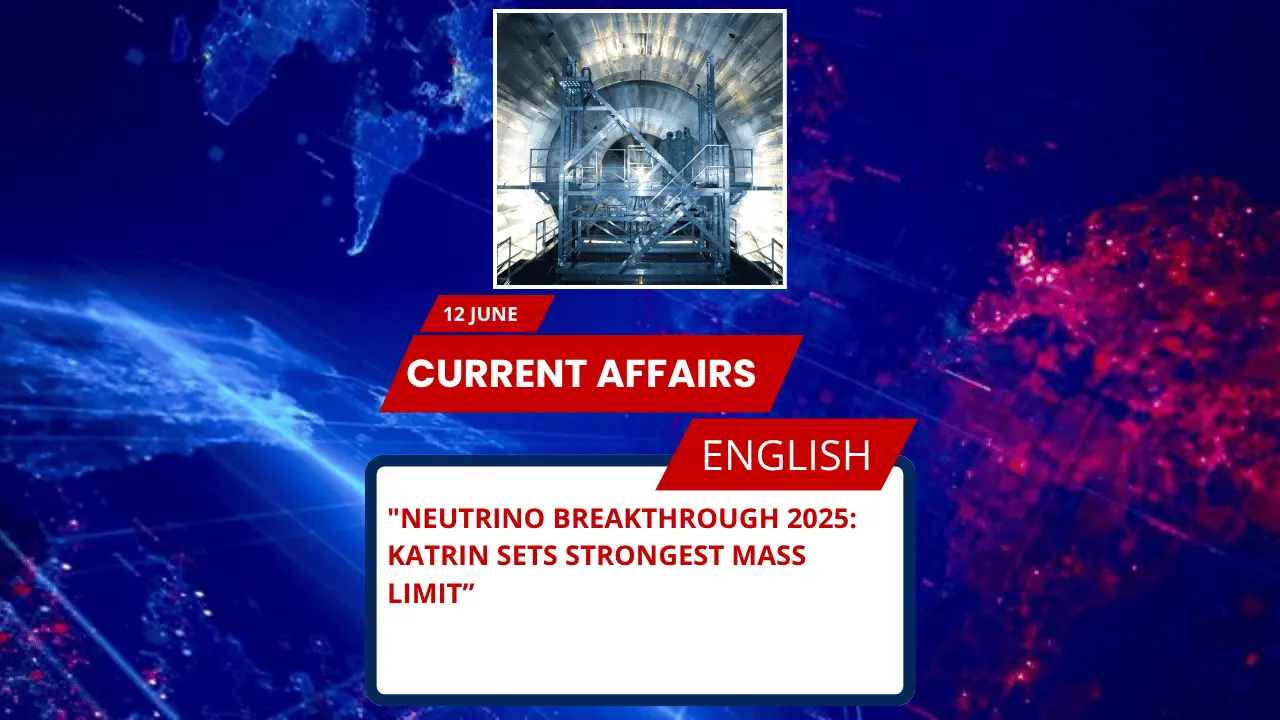
Key Points for SSC, UPSC & Other Exams
- KATRIN (Germany) sets the most precise upper limit on the mass of electron neutrinos.
- Neutrino mass now estimated to be below 0.2 eV.
- Neutrinos are chargeless, nearly massless, and rarely interact with matter.
- Neutrino oscillation proves they have non-zero mass, challenging the Standard Model of physics.
- India’s INO project (Tamil Nadu) is a global-level initiative in neutrino research.
- India first detected atmospheric neutrinos in 1965 at Kolar Gold Fields.
- KATRIN uses tritium beta decay to track the energy of electrons for measuring neutrino mass.
KATRIN Experiment – A Game-Changer in Neutrino Science
What is the KATRIN Experiment?
The Karlsruhe Tritium Neutrino (KATRIN) Experiment is a large-scale research project located at the Karlsruhe Institute of Technology (Germany). It aims to measure the absolute mass of electron antineutrinos with unprecedented sensitivity.
- Inauguration: 2018
- Data Collection: Started in 2019
- Recent Result (2025): Uses 259 days of collected data
KATRIN studies beta decay of tritium, where it breaks into helium, an electron, and a neutrino. It focuses on electrons emitted near the energy endpoint—these are most influenced by the neutrino’s mass.
What Are Neutrinos?
- Subatomic particles with no electric charge and very small mass.
- Exist in three types (flavours): electron, muon, and tau neutrinos.
- Created during nuclear reactions, such as those in the Sun, reactors, and supernovae.
- Travel close to the speed of light and barely interact with matter.
- Exhibit oscillation (change from one type to another), proving they have non-zero mass.
- Their behavior challenges the Standard Model, suggesting the existence of undiscovered particles or forces.
How Does KATRIN Measure Neutrino Mass?
Scientific Approach
- KATRIN filters and detects high-energy electrons using a retarding electric field.
- These electrons are produced when tritium decays into helium, an electron, and a neutrino.
- By observing millions of beta decay events, the experiment narrows down the upper mass limit of neutrinos to below 0.2 eV, the most stringent limit yet.
India’s Role in Neutrino Research
Early Achievements
- In 1965, India became the first country to detect atmospheric neutrinos at Kolar Gold Fields (KGF).
India-Based Neutrino Observatory (INO)
- Located in Tamil Nadu, under development.
- Will host the Iron Calorimeter (ICAL), the world’s largest magnetized neutrino detector (50,000 tonnes).
- Will strengthen high-energy physics research and support technological innovation in fields like medical imaging and electronics.
- INO complements international initiatives like IceCube (Antarctica) and KATRIN (Germany).
Important Facts About Mentioned Places and Institutions
Germany
- Capital: Berlin
- Currency: Euro (€)
- Notable Research Facility: Karlsruhe Institute of Technology (KIT)
Tamil Nadu (India)
- Capital: Chennai
- Chief Minister: M. K. Stalin (as of 2025)
- Major Rivers: Kaveri, Vaigai
- National Parks: Mudumalai, Guindy, Indira Gandhi NP
- Significant Research Project: India-based Neutrino Observatory (INO)
MCQs Based on the Topic
Q1. What is the primary goal of the KATRIN experiment?
(a) To detect gravitational waves
(b) To analyze solar flares
(c) To determine the absolute mass of neutrinos
(d) To detect gamma ray bursts
Correct Answer: (c)
Q2. Which Indian site recorded the first detection of atmospheric neutrinos?
(a) BARC, Mumbai
(b) Kolar Gold Fields
(c) ISRO, Bengaluru
(d) INO, Tamil Nadu
Correct Answer: (b)
Q3. What is the principle behind the KATRIN experiment?
(a) Neutron decay
(b) Muon oscillation
(c) Tritium beta decay
(d) Higgs boson interactions
Correct Answer: (c)
Q4. Which of the following statements about neutrinos is incorrect?
(a) They have zero mass
(b) They oscillate between different flavours
(c) They travel nearly at light speed
(d) They are produced during nuclear reactions
Correct Answer: (a)
UPSC-style FAQs and Model Answers
Q1. What are neutrinos and why are they important in particle physics?
Answer:
Neutrinos are electrically neutral subatomic particles with a very small, non-zero mass. They are produced in nuclear reactions like beta decay and are known for their weak interaction with matter. Their significance lies in their ability to oscillate between different flavours (electron, muon, and tau), a phenomenon that contradicts the predictions of the Standard Model of particle physics. Studying neutrinos helps physicists explore physics beyond the Standard Model, investigate the mass hierarchy problem, and understand fundamental symmetries in nature.
Q2. Discuss the significance of the KATRIN experiment in the study of neutrinos.
Answer:
The KATRIN (Karlsruhe Tritium Neutrino) experiment marks a major scientific advancement by setting the strongest upper limit on the mass of the electron neutrino (less than 0.2 eV). By precisely measuring the energy spectrum of electrons from tritium beta decay, it isolates those near the endpoint—most sensitive to neutrino mass. This contributes to resolving key puzzles in cosmology, such as the role of neutrinos in dark matter and galaxy formation. KATRIN thus plays a vital role in refining the Standard Model and guiding future theoretical and experimental research.
Q3. Evaluate India’s role in global neutrino research with a focus on the INO project.
Answer:
India has played a pioneering role in neutrino science, beginning with the first atmospheric neutrino detection at Kolar Gold Fields in 1965. The India-based Neutrino Observatory (INO) is an ambitious national project aimed at placing India at the forefront of global neutrino research. Located in Tamil Nadu, it will house the Iron Calorimeter (ICAL), the world’s largest magnetized neutrino detector. INO’s goals include advancing fundamental research, fostering scientific manpower, and enhancing global collaborations. Its strategic relevance is high, as it will complement global experiments like KATRIN and IceCube.







